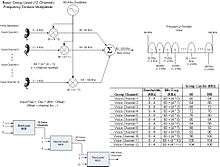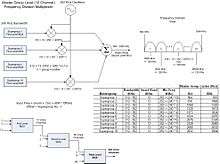L-carrier
| System | Year | Frequency | Coax per cable |
Distance between repeaters |
Voice circuits per coax tube |
|---|---|---|---|---|---|
| L-1 | 1941 | 3 MHz | 4 | 8 miles | 600 |
| L-2 | 1942 | 840 kHz | 4 | 16 miles | 360 |
| L-3 | 1950 | 8 MHz | 8 | 4 miles | 1,860 |
| L-4 | 1967 | 17 MHz | 20 | 2 miles | 3,600 |
| L-5 | 1972 | 57 MHz | 22 | 1 mile | 10,800 |
| L-5E | 1975 | 66 MHz | 22 | 1 mile | 13,200 |
The Transcontinental Cable System or L-carrier system was developed by AT&T to create a high capacity transmission facility using coaxial cable, a fairly new medium for HF to RF signal transmission invented in 1927 by Lloyd Espenschied of Bell Telephone Laboratories[1] for long distance communications. There were six phases of development of the system, designated by the Bell System as L-1 through L-5E. Later versions, starting in the early 1960s, were hardened against the dangers of the cold war using complete placement of all terminal and repeater equipment in hardened underground vaults.
The initial system developed in the late 1930s had 600 voice channels, far more than could be carried by balanced pair carrier systems, and cheaper per channel for high-usage routes. This version was standardized as "Type L Telephone Carrier System" in 1938, abbreviated at "L-1" after further developments ensued. The first commercial usage of this then-new technology appeared with the construction of the Los Angeles-El Paso "A" cable, which was later upgraded to L-3 in 1956. Each successive version, excepting the 360 channel "L-2," had at least twice as many channels as the previous version, culminating in the L-5E design in 1976. (There was only one L-2 ever deployed, between Washington DC and Baltimore.) AT&T Long Lines built two coast to coast systems of L-3 as well as shorter ones connecting major cities, especially the big cities of the eastern United States, as a supplement to the mainstay microwave radio relay systems. Some were later upgraded to L-4, while others were simply overbuilt with a new L-5 system.



Starting in 1911, telephone networks used frequency-division multiplexing to carry several voice channels on a single physical circuit, beginning with the first Type C carrier in that year, which heterodyned three voice channels stacked on top of one voice circuit.[2] L-carrier systems were loaded by multiplexing and supermultiplexing single sideband channels, using the long-standard 12 channel voice "group" produced by Type A channel banks, occupying a frequency spectrum between 60 and 108 kHz. This basic "group" was the entire line spectrum on previous long haul carrier systems, such as Types J and K. The first Type A-1 channel banks appeared for use on Type J open wire carrier in 1934.[2] It was the work of the aforementioned Espenschied and Herman Affel of Bell Labs who patented their piezoelectric crystal "lattice" filters to provide sharp bandpass cutoff that made all single-sideband carrier work developed at Bell Labs possible. Such "lattice" filters were the heart of all analog multiplex systems using single-sideband/carrier suppressed architecture until active IC-based filtering became available in the mid-1970s.
In single-sideband modulation schemes, twelve voice channels would be modulated into a channel group. In turn, five groups could themselves be multiplexed by a similar method into a supergroup, containing 60 voice channels. One 48 kHz group-band circuit was sometimes used for a single high speed data link rather than for voice circuits. Also, entire supergroups could be dedicated as a single data channel running a data rate of 56 kbit/s as early as the late 1960s.
In long distance systems, supergroups were multiplexed into mastergroups of 300 voice channels (European CCITT hierarchy) or 600 (AT&T Long Lines Type L-600 Multiplex) for transmission by coaxial cable or microwave.
There were even higher levels of multiplexing, and it became possible to send thousands of voice channels down a single circuit. For example, Type L-4 system used the "Multi-Master Group" system to stack six U600 mastergroups into the L4 line spectrum, while the same hardware was modified to take three of these MMG spectra and stack them into an early L5 line spectrum. Later advancements in technology allowed for even more stacking on the Type L-5E, allowing 22 mastergroups to be stacked into a 66 MHz line spectrum. The accompanying diagrams are of the process of a Bell System A type channel bank forming a mastergroup in three stages.
L-carrier also carried the first television network connections, though the later microwave radio relay system soon became more important for this purpose. Type L-3 was used for a short time for coast-to-coast network television feeds, but the advent of NTSC color was the cause for the move to Type TD microwave radio. The tube repeaters of the L-3 added too much group delay to the baseband broadcast signal for the cables to be of much use to broadcasters, and "L-pipes" weren't used for broadcast television much as around 1964.[3]
A variant of the 1950 L-3 system was designed in the early 1960s to provide for land line connections between key command and control facilities inside the United States. Starting with L-3I (improved) the system was upgraded to withstand a nuclear attack. The system consisted of over 100 "main stations" and 1000 individual repeater vaults. The "main stations" had emergency generators, blast doors and accommodations for staff for a two-week post-attack period. Nuclear early warning systems, blast detection and other emergency services were generally provided by redundant underground and microwave circuits in case one failed.
In the late 1970s and early 1980s the system was determined to be redundant with the advance of satellite and fiber-optic communication. A few cables were upgraded to T-4 and T-5 instead of L-5, but most were never upgraded past L-4 due to advancement of technology. Generally, the advancement of glass fiber and laser technology made copper coaxial cable obsolete for all long haul carrier service, as Western Electric had finally fielded the FT Series G single-mode fiber cable system by 1984.[4]
References
- ↑ "Bell Labs Journal," ®1974 AT&T Corporation, Nokia Bell Labs
- 1 2 "Basic Principles of Electricity for Telephone Work," ©1938, AT&T Long Lines Department
- ↑ Recollections of early network television service at the Los Angeles Television Operating Center, c. 1980, Robert V. Scarborough
- ↑ "Advancements In Fiber Technology," Bell Telephone Labs